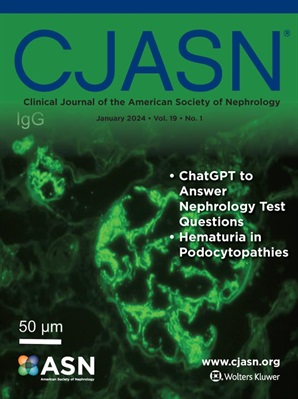The Emerging Nephrology Physician Workforce in the United States: Defining an Impending Shortfall
IF 8.5
1区 医学
Q1 UROLOGY & NEPHROLOGY
Clinical Journal of the American Society of Nephrology
Pub Date : 2025-06-09
DOI:10.2215/cjn.0000000716
引用次数: 0
Abstract
ded match data for this retrospective study of US nephrology fellowship applicants (2009-2024). Annual trends were analyzed with linear regression. Results: The annual number of nephrology fellowship programs (142 to 180, 26.8% higher, P<0.001) and training positions (367 to 488, 33.0% higher, P<0.001) were higher over the study period. In contrast, the annual number of applicants were lower (578 to 362, 37.4% lower, P<0.001). The annual applicant-to-training position ratio was lower (1.6 to 0.7, P<0.001) while the annual match rate was higher (60.2% to 89.4%, P=0.004). The annual rate of unmatched training positions were higher (5.2% to 34.2%, P<0.001) and the percentage of applicants that matched at their first-choice ranked fellowship were higher (37.2% to 60.4%, P=0.02). The annual representation of US allopathic graduates were lower (37.9% to 25.5%, P=0.05 while the annual representation of US osteopathic graduates were higher (4.9% to 16.5%, P<0.001). The annual representation of international medical graduates remained similar (57.2% to 57.9%, P=0.15). Conclusions: The annual number of training positions in nephrology have been higher without commensurate growth in the number of applicants. The rate of unmatched training positions is becoming higher with potential deleterious consequences to future US nephrologist workforce adequacy. Accelerated efforts are needed to emphasize the attractiveness of the specialty and stimulate interest among applicants. Surveillance of future nephrology match outcomes is warranted. Copyright © 2025 by the American Society of Nephrology...美国新兴的肾脏病医师队伍:确定即将出现的短缺
本研究回顾性分析了2009-2024年美国肾病学奖学金申请者的匹配数据。用线性回归分析年趋势。结果:在研究期间,肾内科年度奖学金项目数量(142 ~ 180个,增加26.8%,P<0.001)和培训岗位数量(367 ~ 488个,增加33.0%,P<0.001)均有所增加。相比之下,每年申请人数较低(578人比362人,低37.4%,P<0.001)。年度应聘岗位与培训岗位之比较低(1.6 ~ 0.7,P<0.001),而年度匹配率较高(60.2% ~ 89.4%,P=0.004)。年度培训职位不匹配率较高(5.2%对34.2%,P<0.001),申请人在其首选排名奖学金中匹配的比例较高(37.2%对60.4%,P=0.02)。美国对抗疗法毕业生的年度代表性较低(37.9%至25.5%,P=0.05),而美国整骨疗法毕业生的年度代表性较高(4.9%至16.5%,P<0.001)。国际医学毕业生的年度代表性保持相似(57.2%至57.9%,P=0.15)。结论:肾内科年度培训岗位数量增加,但申请人数没有相应增长。不匹配的培训职位的比率正变得越来越高,这对未来美国肾病专家的劳动力充足性有潜在的有害后果。需要加快努力,强调专业的吸引力,激发申请人的兴趣。对未来肾脏匹配结果的监测是必要的。版权所有©2025 by美国肾脏学会…
本文章由计算机程序翻译,如有差异,请以英文原文为准。
求助全文
约1分钟内获得全文
求助全文
来源期刊
CiteScore
12.20
自引率
3.10%
发文量
514
审稿时长
3-6 weeks
期刊介绍:
The Clinical Journal of the American Society of Nephrology strives to establish itself as the foremost authority in communicating and influencing advances in clinical nephrology by (1) swiftly and effectively disseminating pivotal developments in clinical and translational research in nephrology, encompassing innovations in research methods and care delivery; (2) providing context for these advances in relation to future research directions and patient care; and (3) becoming a key voice on issues with potential implications for the clinical practice of nephrology, particularly within the United States. Original manuscript topics cover a range of areas, including Acid/Base and Electrolyte Disorders, Acute Kidney Injury and ICU Nephrology, Chronic Kidney Disease, Clinical Nephrology, Cystic Kidney Disease, Diabetes and the Kidney, Genetics, Geriatric and Palliative Nephrology, Glomerular and Tubulointerstitial Diseases, Hypertension, Maintenance Dialysis, Mineral Metabolism, Nephrolithiasis, and Transplantation.

 求助内容:
求助内容: 应助结果提醒方式:
应助结果提醒方式:


